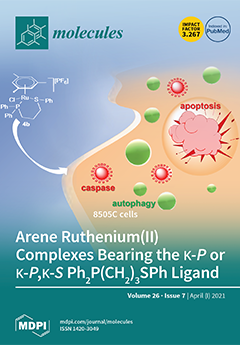Periodontitis is a set of chronic inflammatory diseases caused by the accumulation of Gram-negative bacteria on teeth, resulting in gingivitis, pocket formation, alveolar bone loss, tissue destruction, and tooth loss. In this study, the contents of ginsenosides isolated from
Panax ginseng fruit extract
[...] Read more.
Periodontitis is a set of chronic inflammatory diseases caused by the accumulation of Gram-negative bacteria on teeth, resulting in gingivitis, pocket formation, alveolar bone loss, tissue destruction, and tooth loss. In this study, the contents of ginsenosides isolated from
Panax ginseng fruit extract were quantitatively analyzed, and the anti-inflammatory effects were evaluated in human periodontal ligament cells. The major ginsenosides, Re, Ra8, and Rf, present in ginseng fruit were simultaneously analyzed by a validated method using high-performance liquid chromatography with a diode-array detector; Re, Ra8, and Rf content per 1 g of
P. ginseng fruit extract was 1.01 ± 0.03, 0.33 ± 0.01, and 0.55 ± 0.04 mg, respectively. Ginsenosides-Re, -Ra8, and -Rf inhibited the production of pro-inflammatory factors and the expression of important cytokines in periodontitis by inducing the expression of heme oxygenase 1 (HO-1), promoting osteoblast differentiation of periodontal ligament cells, suppressing alveolar bone loss, and promoting the expression of osteoblast-specific genes, such as
alp,
opn, and
runx2. An inhibitory effect of these ginsenosides on periodontitis and alveolar bone loss was observed via the regulation of HO-1 and subsequent epidermal growth factor receptor (EGFR) signaling. Silencing EGFR with EGFR siRNA confirmed that the effect of ginsenosides on HO-1 is mediated by EGFR. In conclusion, this study evaluated the contents of ginsenosides-Re, -Ra8, and -Rf isolated from
P. ginseng fruit extract. Therefore, these results provide important basic data for future
P. ginseng fruit component studies and suggest that ginsenosides Re, Ra8, and Rf have potential as future treatment options for periodontitis.
Full article






